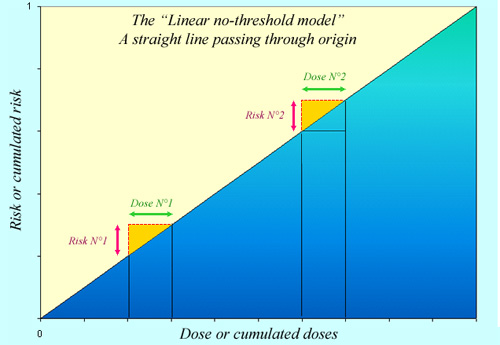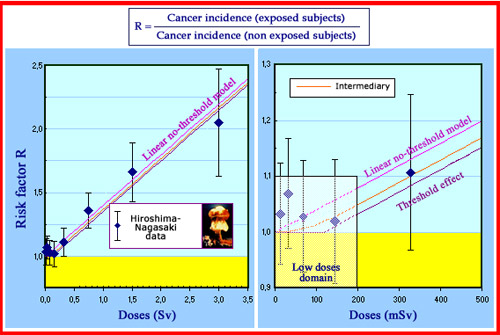A Precautionary Principle applied to radioactivity …

A simple practical law
The proposed proportionality between dose and effects can be shown on a dose-effect diagram by a ‘linear relationship with no threshold’ : – a straight line going through the origin. The relationship apply to a single dose or for cumulative doses as well : the effect of a dose is not changed by previous exposures – each dose absorbed can be viewed as independent of any others. The proportionality apply to all ranges ( not specified on the figure) of doses : the risk is never zero. even for very low doses. This relationship, practical for regulating radioprotection recommandations, is not a law of nature.
© IN2P3
Is it possible to predict the effects of a dose of exposure to radiations ? The UNSCEAR and the ICRP, the radioprotection institutions in charge of issuing directives and recommendations on an international level, have proposed a simple rule. In the technical jargon, this rule – considered as a reference – is called the ‘linear no-threshold model ‘..
This important relationship is an application of a ‘precautionary principle‘. The point is to set the maximum possible risks posed by radioactivity exposure. The ICRP rule states in simple terms that the risks are directly proportional to the doses absorbed. This proportionality is represented by a straight line (a linear relationship) on a graph which passes through the origin. Considering for instance the probability that a dose triggers a potentially mortal cancer, the ICRP claims that the proportionality rate is of 5% per sievert …
The virtue of this linear relationship is its simplicity; and if it does indeed hold then it implies that doses and risks add up independently. This means that a patient can pass through a scanner without having to worry about any previous radiation he may have absorbed.
One of the consequences of this proportionality is that the risk remains even for very weak doses. The idea that doses of even a few millionths of a sievert can pose a threat is one that has divided the scientific community. Many radiobiologists, claim that below a certain level (known as the threshold), the risk is nonexistent. Such for instance, is the point of view in France of the Medicine Academy.
Take as an analogy a rainfall of feathers onto a city. The idea of a threshold comes into play when considering that it takes a certain weight of feathers falling onto an individual to cause any damage. A million feathers landing on a million heads would go unnoticed because a feather weight is below the threshold of being harmful, but a bag with a million feathers falling onto one person’s head could kill her.
If we assume the absence of a threshold and say that even one feather has a small probability of causing a death, then the total number of deaths should be identical whether the feathers are falling individually or in heavy bags. This paradox is at the core of the controversy about the model.

A range of competing models
The data currently available on the effects of radiation is mostly taken Hiroshima and Nagasaki survivors, and is riddled with large errors due to lack of statistics. The graph on the left shows how, for doses between 0 and 3 sieverts, the rate of the ‘linear relationship with no threshold’ can be determined. The margins of errors do not allow us to distinguish between this straight line with a threshold effect and two intermediary model. The magnified view on the right shows the range of doses below 500 mSv, where the risks predicted by the three models vary significantly. In this domain of low doses, it seems not possible to choose between the models, even if their predictions differ considerably..
© IN2P3
The linear relationship was established based on observations made of comparatively high doses. The lack of reliable data has led to massive speculation with regards to what happens in the range of doses below 100 or 200 mSv. A linear relationship with no threshold clearly overestimates the risks posed by low doses if, in reality, this threshold did exist.
Despite its limitations, the relationship has a useful regulatory role because it provides an easy and effective framework for radiation protection.
Other articles on the subject « Radiation Effects »
Deterministic effects
The domain of strong doses and severe, reproducible effects For high doses above a certain thresh[...]
Probabilistic effects
The domain of low and average doses For weak or medium-strength doses, the effects are not as cle[...]
Dose-effects Relationship
Can effects caused by low doses of radiations be predicted ? Even though we are constantly expose[...]
Cumulative Dose
What is the cumulative exposure? We receive an average of 2.5 millisieverts (mSv) per year from n[...]
Dose Rate
Acute and chronic exposures The « effective dose » is not sufficient by itself to characterize on[...]
Hiroshima Nagasaki Survivors
An exces of cancers and leukaemia among survivors Our knowledge of the risks of cancers due to ra[...]
Low doses effects
Do low doses of radiation have any effect? Radioprotection experts commonly refer to doses below [...]
Radiosensitivity
Sensitivity of DNA in living cells to radiation Although we still know little about the effects o[...]
Radioactive Toxicity
A useful indicator but to be used appropriately … The danger presented by a radioactive sub[...]
Dose Factors
What doses when swallowing or inhaling radioactive atoms ? How to evaluate the doses resulting fr[...]